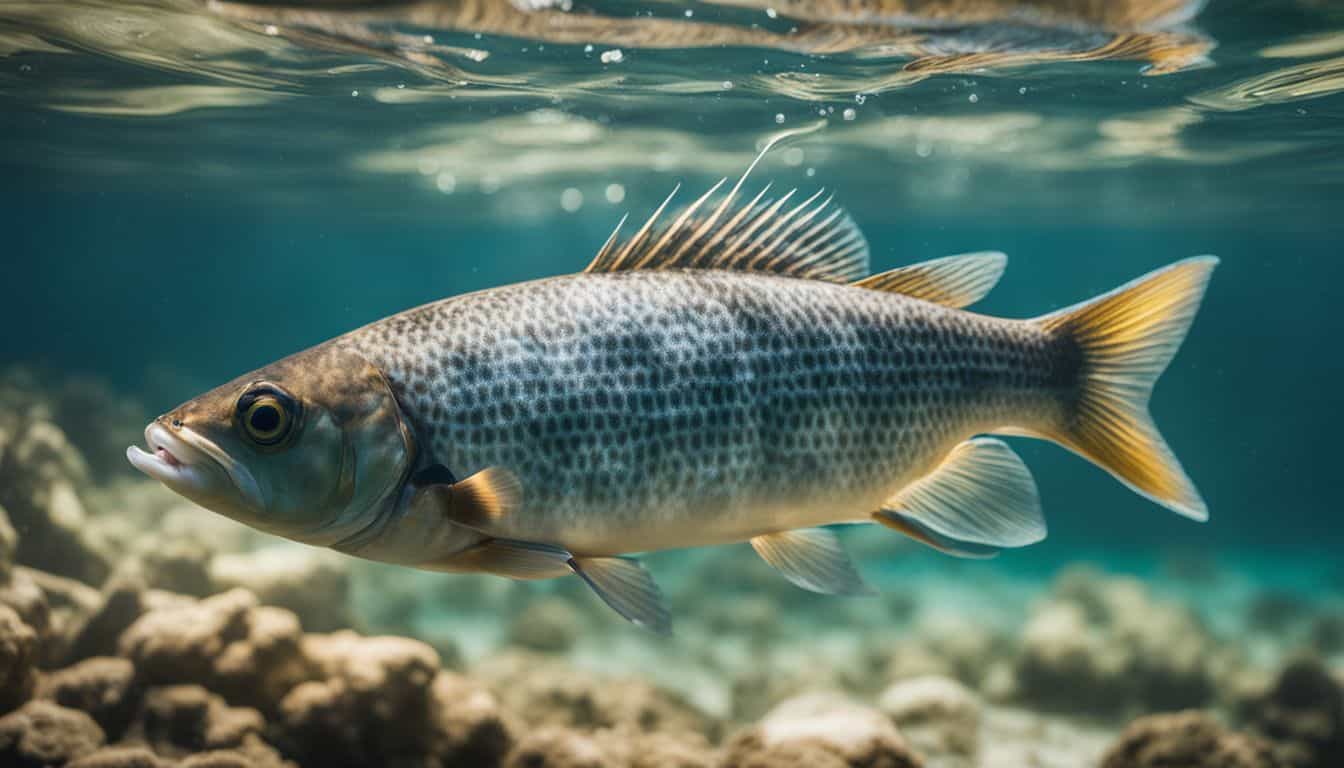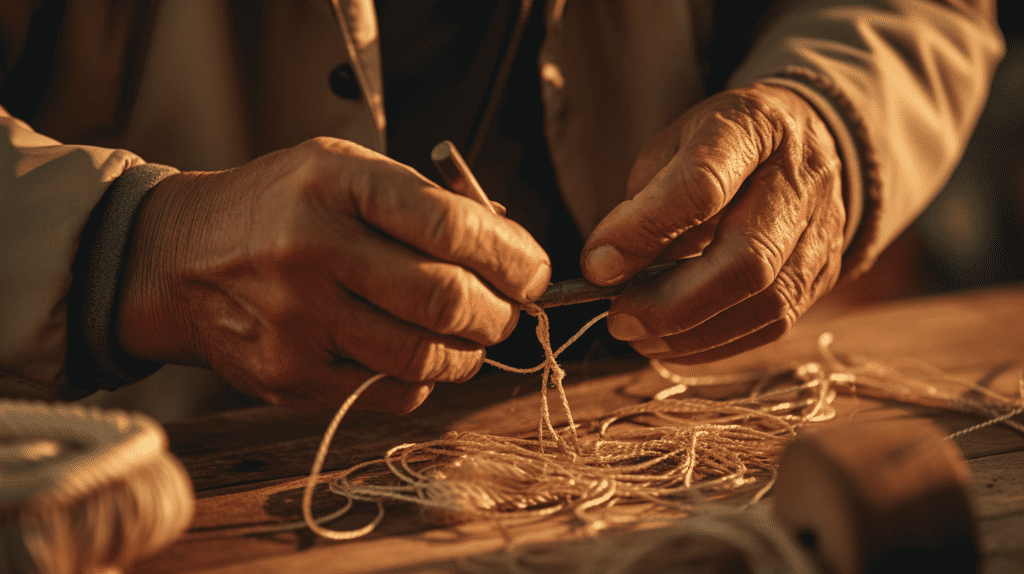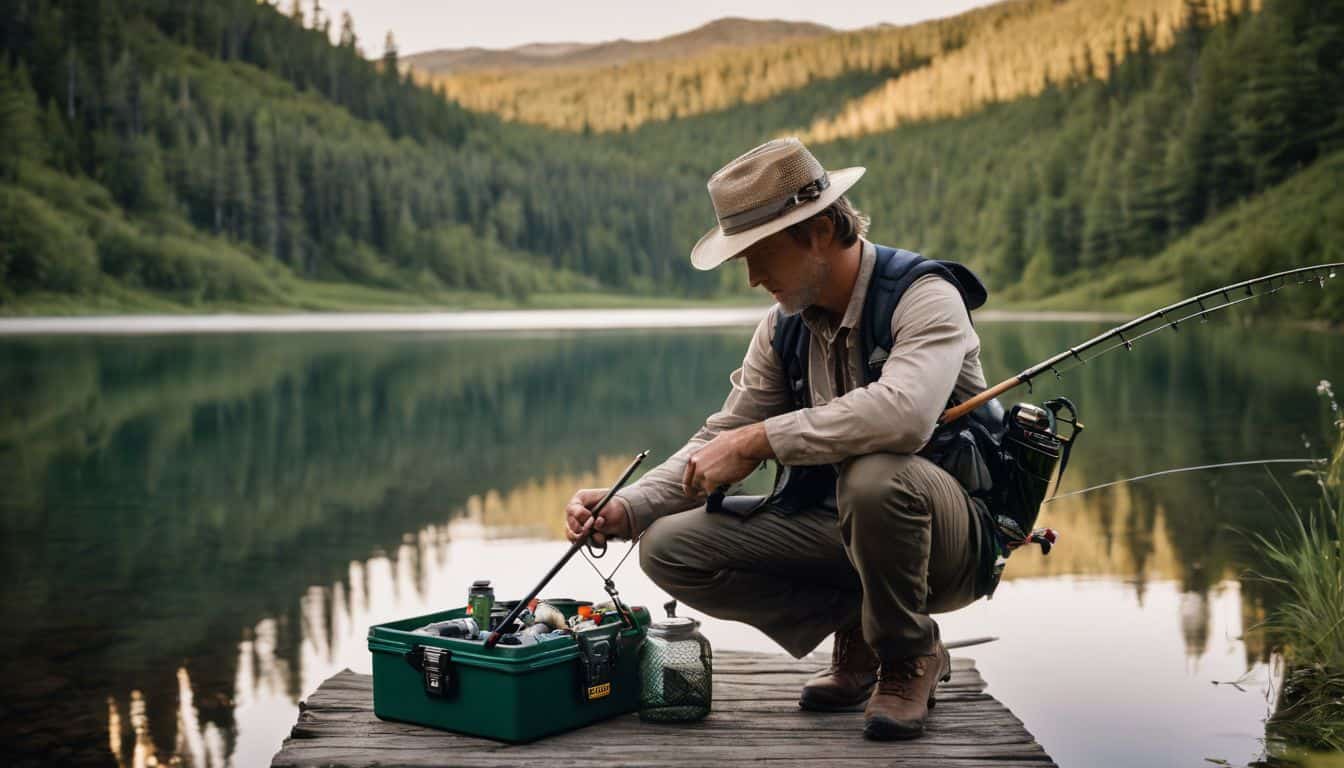Do you ever find yourself wrestling with the ethics of angling, wanting to make sure that your catch gets to flip its fins another day? Trust me, I’ve navigated those waters. After diving headfirst into extensive research and firsthand experiences, I unraveled that effective catch-and-release tactics can play a crucial role in preserving our invaluable fishing resources.
This blog is like a treasure chest for any avid angler – brimming with 15 enlightening tips to perfect the art of catch-and-release practices for a more sustainable fishing future.
So strap in – it’s time to cast out some sage wisdom!
Key Takeaways
- Catch and release fishing is a way to help fish live and protect the environment.
- Choosing the right gear, handling fish with care, releasing at the right depth, using catch-and-release nets, and removing hooks properly are important for successful catch and release.
- Using barbless hooks and facilitating quick hook removal can minimize injury to fish during catch and release.
- Having a quick fight, getting the fish back in the water quickly, using figure eights technique, and flattening barbs on hooks are additional tips for successful catch and release fishing.
What is Catch and Release Fishing?
Catch and release fishing is a way to help fish live. We do it to stop too many fish from being caught. It helps more fish stay in the water and make babies. This makes the number of fish grow in their home, or ecosystem.
This way of fishing came because there are so many people now and they care about nature. People who love to fish, or anglers, like catch and release fishing a lot. It lets them enjoy the sport but still think about how we must protect nature.
So that’s what catch and release fishing is all about – saving our waters while having fun.
Effective Catch and Release Techniques
To ensure a successful catch and release, it is essential to choose the right gear, handle the fish with care, release at depth, use catch-and-release nets, remove hooks properly, and revive the fish carefully.
Choose the Right Gear
Your gear makes a big impact on fish. Rods, reels, and lines should be pick well for catch and release fishing. A strong rod helps you land the fish fast. This lowers the stress on the fish.
Artificial lures or flies are better than bait. They cause less harm to the fish’s mouth. Also, picking the right line is key for not hurting the fish too much. So always have in mind that good gear selection keeps caught fishes safe.
Handle With Care
Being gentle with the fish is important. I make sure not to gaff a fish that will go back into the water. This will keep it from getting hurt. It is best to take out the hook while it’s still in water.
This can help lower stress for the fish and keep it alive. If taking out the hook gets hard, I cut the line as near to the hook as I can. These tricks are some of many proper release techniques which we should follow when we catch a fish and want to put it back so that more people can enjoy fishing in future times!
Release at Depth
When catch and release fishing, it is important to release the fish at the right depth. This is because fish caught in deep water can experience barotrauma. Barotrauma happens when the pressure changes rapidly, causing damage to the fish’s internal organs.
If a deep-dwelling fish suffers from barotrauma and is released, it may not survive. To improve their chances of survival, consider using tools like descending devices or venting tools to help them return to their normal depths safely.
By releasing fish at the appropriate depth, we can promote sustainability and protect fish populations for future generations of anglers like us.
Use Catch-and-Release Nets
Using catch-and-release nets is a crucial step in effective catch and release fishing. These nets are designed to help safely land, photograph, and release fish without causing harm.
It is recommended to use a good quality catch and release net made of rubber mesh whenever possible. These nets are gentle on the fish’s scales and fins, reducing the risk of injury during handling.
By using catch-and-release nets, we can ensure that the fish have the best chance at survival after being released back into the water. This contributes to sustainable fishing practices and helps maintain healthy fish populations for future generations of anglers to enjoy.

Remove Hooks Properly
Removing hooks properly is essential for the successful catch and release of fish. Here are some tips to ensure you do it right:
- Use a dehooker or release tool: These tools can minimize handling and make it easier to remove the hook without taking the fish out of the water.
- Choose barbless hooks: Barbless hooks have been proven to reduce handling time and decrease mortality rates associated with catch and release fishing.
- Safely remove treble hooks: If you’re using treble hooks, use wire snips or pliers to remove two hooks at a time.
- Flatten barbs: Flattening the barb against the hook shank can help remove the barbs from hooks, making it easier to free the fish.
- Be gentle when removing the hook: Avoid squeezing or harming the fish when taking out the hook. Handle them with care to minimize stress and injury.
Revive the Fish Carefully
Reviving a fish carefully is crucial for its survival after catch and release. Here are some tips to do it right:
- Move the fish gently: Avoid unnecessary handling and movement of the fish as it can further stress it out.
- Face into the current: If you’re in a river or stream, position the fish facing into the current. This helps oxygen-rich water flow over its gills, helping it breathe.
- Force water gently: To aid resuscitation, you can gently force water into the fish’s mouth and over its gills. Be careful not to use excessive force that could harm the fish.
- Give it time: Allow the fish to regain its strength and swim away on its own before releasing it fully. This ensures that it has fully recovered.
Importance of Minimizing Injury
Minimizing injury is crucial to the success of catch and release fishing. Using barbless hooks and facilitating quick hook removal are key techniques to ensure the fish’s well-being.
Learn more about these important practices by reading the full blog post!
Use Barbless Hooks
Using barbless hooks is crucial for successful catch and release fishing. Barbless hooks make the process easier and quicker, benefiting both anglers and fish. They minimize the risk of getting a hook stuck in your body, ensuring angler safety.
Additionally, barbless hooks significantly reduce injuries and bleeding in fish during catch-and-release fishing. Studies have shown that these hooks not only decrease fish injury but also make it easier to remove the hook quickly and safely.
By using barbless hooks, you contribute to fish conservation efforts by minimizing injury and maximizing the chances of a successful release back into their natural habitats. So remember, when practicing catch and release, always opt for barbless hooks to protect both yourself as an angler and the well-being of the fish you love to catch!
Facilitate Quick Hook Removal
Removing the hook quickly is important for catch and release fishing. It helps minimize injury to the fish and improves their chances of survival. Here are some tips to facilitate quick hook removal:
- Use barbless hooks: Barbless hooks are designed to make it easier to remove the hook from the fish’s mouth without causing additional harm.
- Bring the right tools: Have a pair of pliers or forceps handy to help you remove the hook quickly and efficiently.
- Minimize handling time: The longer you handle a fish, the more stress it experiences. Remove the hook as quickly as possible to reduce stress on the fish.
- Avoid excessive pressure: Apply gentle pressure when removing the hook to avoid causing unnecessary damage to the fish’s mouth or jaw.
- Cut the line if needed: If a fish is deeply hooked and it would cause more harm to try and remove the hook, cut the line close to the mouth instead. This can be a better option for both you and the fish.
Tips for Successful Catch and Release
Quick Fight: When reeling in a fish, try to bring it in quickly to minimize stress and exhaustion. This will increase its chances of survival once released.
To discover the rest of the tips for successful catch and release fishing, visit our blog now!
Quick Fight
When it comes to catch and release fishing, having a quick fight with the fish is important. This means reeling in the fish as efficiently as possible without prolonging the battle.
Decreasing the fight time reduces stress on the fish, increasing its chances of survival once released. So, when you feel that tug on your line, be ready to reel in quickly and bring that fish in without unnecessary delay.
By doing so, you are ensuring a higher rate of success for both you and the fish.
Get Back Down
To ensure the best chance of survival for a released fish, it’s important to get it back down into the water as quickly as possible. When lifting the fish out of the water, do it in short intervals of five seconds or less.
This helps minimize stress and ensures that the fish can continue breathing properly. Remember, keeping a fish out of water for too long can be harmful to its health and chances of survival.
By getting it back down swiftly, you’re promoting sustainable fishing practices and preserving fish populations for future enjoyment. Let’s keep our aquatic ecosystems healthy!
Figure Eights
When it comes to successful catch and release fishing, using figure eights can be really helpful. What are figure eights? Well, when you’re reeling in a fish, instead of just pulling it straight up, try making a sideways 8 shape with your rod.
This helps tire out the fish more quickly and reduces the risk of breaking your line. Plus, it gives you better control over the fish and can make it easier to bring them closer to the boat or shore.
Using figure eights is especially important if you’re dealing with larger or stronger fish that like to make sudden runs. By keeping steady pressure on the fish while making those sideways 8 movements, you can wear them out faster and avoid overplaying them.
And remember, being gentle but firm is key – try not to jerk your rod too much during these movements.

Flatten Barbs
Flattening the barbs on hooks is an important practice in catch and release fishing. It helps minimize harm to fish when they are caught and then released back into the water. By removing or flattening the barbs, it becomes easier to remove the hook from the fish’s mouth without causing unnecessary damage.
This simple action shows respect for the fish and ensures their well-being during the catch and release process. It may not affect how effective your fishing is, as studies have shown that hook design is more important than whether it has a barb or not.
So, by flattening barbs, you can be a responsible angler while still enjoying sustainable and ethical fishing practices.
Circular Argument
When it comes to tips for successful catch and release fishing, one technique that can be effective is the circular argument. This involves using a gentle circular motion to help revive the fish before releasing it back into the water.
By gently moving the fish in a circular pattern, you can help oxygenate its gills and improve its chances of survival. This technique is especially useful when handling larger or exhausted fish, as it helps them regain their strength before swimming away.
So, if you want to increase your success with catch and release fishing, give the circular argument a try!
Belly Lift
When practicing catch and release fishing, one important tip to remember is to avoid using a belly lift on the fish. The belly lift is when you hold the fish by its belly with your hand or fingers.
This can actually harm the fish’s internal organs, causing injury or even death. Instead, it’s better to support the fish gently from underneath and let it swim away on its own. By avoiding the belly lift technique, we can help ensure that the released fish have a better chance of surviving and thriving in their natural habitat.
Release Promptly
Releasing a fish promptly after catching it is crucial for its survival. When we release a fish quickly, it has a higher chance of going back into the water and recovering from the stress of being caught.
Delayed release can be harmful to the fish and decrease its chances of survival. By releasing the fish promptly, we are giving it the best opportunity to swim away strong and healthy.
Remember, when you catch a fish, handle it with care and avoid keeping it out of the water for too long. The longer you keep a fish out of its natural habitat, the more stressed and exhausted it becomes.
So, as soon as you’ve admired your catch or taken some pictures, gently lower the fish back into the water and let it swim away freely. By releasing promptly, we are doing our part in ensuring sustainable fishing practices and protecting our precious aquatic ecosystems.
Keep Only Fish that Won’t Survive
When practicing catch and release fishing, it’s important to prioritize the well-being of the fish. One way to do this is by keeping only fish that won’t survive if released back into the water.
This means being mindful of any injuries or stress the fish may have experienced during the fight. If a fish appears exhausted or has deep hook wounds, it may be best to keep it for consumption rather than risking its survival by trying to release it.
By making this choice, we can ensure that our fishing practices are sustainable and respectful towards nature.
Additional Resources for Catch and Release Fishing
If you want to learn more about catch and release fishing, there are many additional resources available to help you. Fishing conservation organizations like Trout Unlimited and the Recreational Boating and Fishing Foundation offer valuable information on sustainable fishing practices and fish population management.
These resources provide guidelines on proper fish handling techniques, ethical fishing practices, and responsible angling. Additionally, fish tagging programs conducted by various research institutions allow anglers to participate in collecting data on fish populations and habitat protection efforts.
By utilizing these additional resources, you can enhance your knowledge of catch and release best practices while also contributing to the conservation of our precious fisheries.
Fish habitat protection
Insights from Catch and Release Best Practices: 15 Tips for Achievement
As an avid fishing enthusiast, I have learned a lot about catch and release best practices. These insights have helped me achieve success in maintaining the quality of my fishing experiences.
One important tip is to continuously strive for improvement. By setting goals and evaluating my performance, I am able to identify areas where I can grow and become a better angler.
Additionally, it’s crucial to handle the fish with care during catch and release. Using the right gear, removing hooks properly, and reviving the fish carefully all help minimize their risk of injury.
Another key insight is the importance of using barbless hooks. This makes it easier to quickly remove them, reducing stress on the fish. I’ve also found that practicing quick fights with fish helps minimize exhaustion and trauma when releasing them back into the water.
Other tips include keeping only those fish that won’t survive if released, performing figure eights during lure retrieval, using catch-and-release nets instead of traditional ones, flattening barbs on your hooks to make removal easier, using circular arguments while debating fellow anglers about catch-and-release practices (just kidding!), employing belly lift techniques when handling larger fish, promptly releasing caught fish after capture.
By following these 15 tips for achievement in catch and release practices, you can enhance your fishing skills while contributing to conservation efforts. Remember that catching and releasing is not just about having a successful day on the water – it’s also about preserving our natural resources for future generations of anglers like us! So get out there with confidence knowing you are doing your part in protecting our fisheries.
Conclusion on Catch And Release Best Practices
In conclusion, practicing catch and release fishing is crucial for the conservation of fish populations and the sustainability of angling opportunities. By following these 15 best practices, such as using the right gear, handling fish with care, and promptly releasing them, anglers can ensure the survival of released fish.
Let’s continue to be responsible stewards of our natural resources so that future generations can enjoy the thrill of fishing too.
FAQs on Catch And Release Best Practices
1. Why is catch and release important in fishing?
Catch and release is important in fishing to help maintain healthy fish populations, conserve the environment, and ensure sustainable fishing for future generations.
2. How do I properly handle a fish during catch and release?
To properly handle a fish during catch and release, wet your hands before touching it, support its body with both hands, avoid squeezing or applying excessive pressure, and quickly return it to the water without dropping or throwing it.
3. What should I do if a fish swallows the hook?
If a fish swallows the hook deeply, it’s best to cut the line close to the hook so that you don’t cause further harm to the fish by trying to remove it. The hook will dissolve or eventually be expelled by the fish’s digestive system.
4. Are there any specific techniques I can use to minimize stress on caught fish during catch and release?
Yes, there are several techniques you can use: minimize air exposure by keeping the fish in water as much as possible; remove hooks quickly using proper tools; refrain from taking photos unless absolutely necessary; avoid overcrowding multiple caught fish in one container or net; revive tired fish by gently moving them back and forth in water until they swim away on their own.
5. Can I still eat a legally caught but released sportfish?
It is generally not recommended to eat sportfish that have been released due to potential health risks associated with certain contaminants found in their flesh. It’s best practice to follow local guidelines regarding consumption advisories for specific bodies of water.





Leave a Reply